Last Updated on April 21, 2024 by Afsar
Are you looking for the best PFD for kayaking? Kayaking, canoeing, rafting, and other water sports can be dangerous if you are not taking enough safety precautions. No matter if you are a seasoned swimmer or not, you should take some time to look for a PFD aka personal floatation device. It’s always better safe than sorry. Even if you are planning to kayak for a very short time, it is wise to put a PFD for safety. In this post, I tried to share the top ten best PFDs for kayaking & canoeing. To sort the top PFD for kayaking, I had to go through the factors to consider when making a buying decision. At the end of the post, I shared a guide on how to choose the best PFDs for kayaking and canoeing. Let’s check this chart of top Kayak PFDs first.
Table of Contents
~Best Kayak PFD 2024~
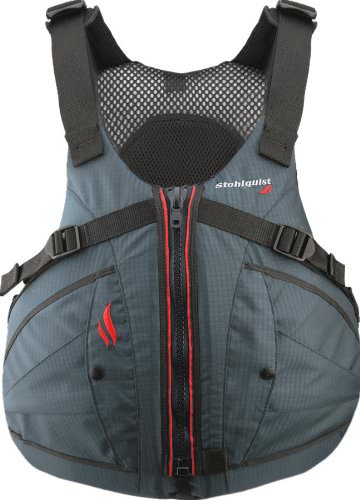
Stohlquist Men’s Ebb Life Jacket/Personal Floatation Device
Best PFD for kayaking (Men): Made of nylon and other materials, this is one of the top PFD for kayaking, canoeing, and rafting. It has a stylish outlook and comes with a 400×200 denier ripstop shell and 210 deniers oxford liner. There is a neoprene padded waistband with it. This PFD is available in two different colors and three sizes.
Stohlquist is one of the best PFDs available for kayakers. The manufacturer used 400×200 denier ripstop shell fabric and 210 denier oxford liner in this beautifully crafted PFD. This lightweight yet amazing personal floatation device has two side entry pockets to keep essentials like keys. If you look closely to the picture, you will notice the Ebb PFD features the Stohlquist chest chin-strap to have a better fit. The eight-point adjustability allows a wide range of fit.
The padded shoulder strap ensures a great amount of comfort to the user and ensures you can easily carry your kayak. The ventilated sides and the mesh back also contribute to the overall enjoyment of wearing this amazing PFD for kayaking. A reflective graphic is used in the PFD for better visibility. On top of that, the high black floatation fits above the seats of most sit-on-top kayaks and canoes. In a nutshell, this proves itself to be one of the best kayak PFDs in the market.
Best for: Longtime kayaking
Color: Steel Green, Red Gray (at the time of writing)
Size: S,M,L,XL,Univ Plus
Notable Features:
- Comfortable
- Lightweight
- Doesn’t affect paddling or moving
- Good quality and fits nicely
- Ventilated sides and back
- The padded shoulder strap is comfortable
- Works excellent with the sit-on-top kayak and canoes
- Reflective graphic used for safety
- Lightweight PE foam
- Two-side entry pockets
- Neoprene padded waistband
- Chest cinch strap

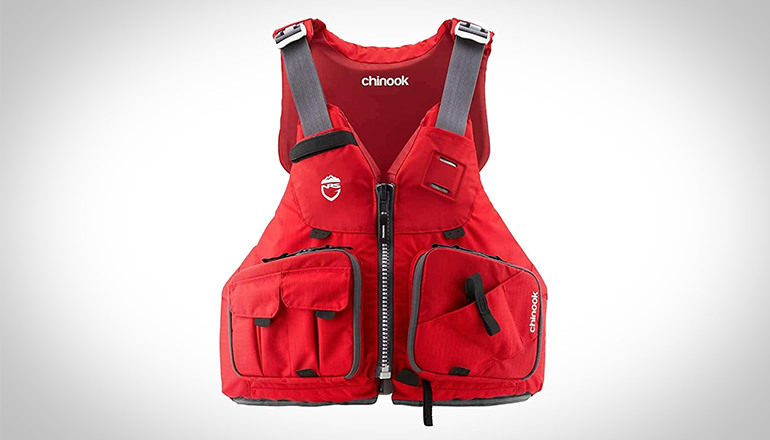
NRS Chinook Mesh Back Kayak Fishing PFD
If you enjoy kayak fishing, the NRS Chinook is the perfect PFD for you. The NRS Chinook offers all of the characteristics that a kayak angler might want. The PFD has many front pockets for storing fishing equipment such as pliers, bait, a filleting knife, and other items. There are rod holder loops, a knife lash tab, and multiple D-rings/attachment loops for attaching other equipment such as a kayak GPS. Chinook has a mesh lower back, making it ideal for a high-back seat in a kayak or canoe. This also provides excellent ventilation if you are kayaking in hot weather.
There is a front zipper on the PFD to make sure you can have an easy on and off experience with this PFD. Eight adjustment points are available in the Chinook to customize the fit for comfort and security. The soft plus fit foam goes smoothly with the body moves as you keep paddling for the day. This kayak PFD is a must for the anglers, and it will not only help you with security but will improve your fishing experience.
Best For: Kayak fishing
Color: Orange, green, charcoal, black
Size: S,M,L,XL, XXL (at the time at the date of writing)
Notable Features:
- Specially made for kayaking
- Excellent ventilation
- Excellent comfortability with security
- Different pockets to store necessary gears and stuff



Stohlquist Trekker Personal Floatation Device
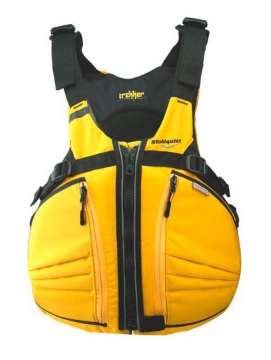
Trekker is another great personal floatation device from Stohlquist. This feature-rich PFD for men comes in different sizes and colors. 500 Denier Cordura shell and the 200-denier oxford liner make this PFD very durable to withstand a harsh environment. Like most other Stohlquist PFDs, Trekker also comes with a Wrapturetm-shaped torso. In the back, the half flotation/half cool mesh keeps the user comfortable while allowing the user to sit comfortably on a kayak seat. The adjustable padded shoulder increases comfort and a good fit.
There is a strap over the chest to keep it under control. This cinch harness ensures zero ride-up. It comes in several vibrant colors to make it easy to spot the PFD on the water. There are two zippered pockets on the front to keep your necessary items like cell phone, keys, GPS device, or other stuff. This kayak PFD comes in some vibrant colors like red, yellow, green, and more. Considering a vivid color like yellow can significantly improve your chances of getting rescued if anything terrible happens.
Best For: touring/kayaking/paddling
Color: Mango, red, bright green, deep red, fireball red, sapphire blue, black
Size: S/M, L-XL, XX-large, Univ Plus
Notable Features:
- Easy front zippered entry
- Ventilated padded shoulder
- Front zippered pocket to keep small belongings
- Comfortable to wear
- Available in bright and vivid colors
- Wrapturetm shaped torso
- Mesh back
- Adjustable padded shoulder


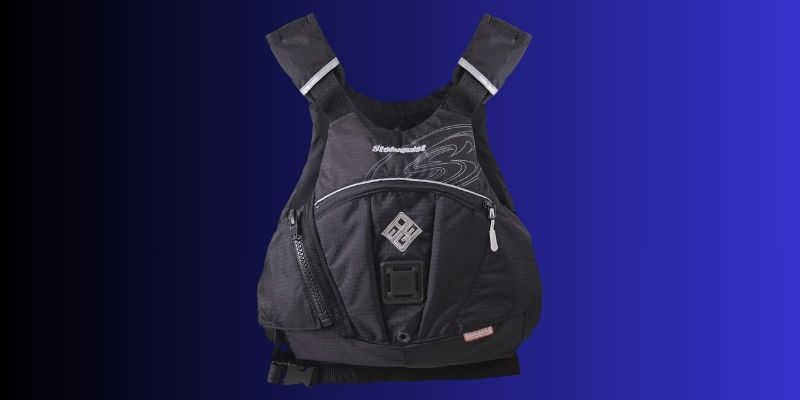
Stohlquist Edge – Life jacket/ PFD
Stohlquist Edge uses a 200D oxford liner, mini-ripstop nylon shell, and an ergonomic WRAPTURE torso to make this amazing PFD. Hundreds of kayakers loved how this personal floatation device offered them protection while kayaking or canoeing. It is available in four colors: black, red, gray, and royal blue. Stohlquist Edge’s shoulders are adjustable and can be adjusted to have a great fit. Four side pulls with front waist buckle closure adds extra adjustment and fitting ability.
As a kayaker will need enough flexibility to paddle, a large arm opening is provided in the jacket. This ensures that the kayaker will have enough space for their arm to move easily. Stohlquist Edge also has other cool features like a front pocket, 3M reflective accents, mesh sides, and contoured padded shoulder straps.
Best For: Kayakers who love extra space
Color: Black, grey, red, Royal blue
Size: S/M, L-XL, XX
Notable Features:
- Ergonomic WRAPTURE torso
- 200D Oxford liner
- Mini-ripstop nylon shell
- Adjustable shoulder
- Front waist buckle closure
- Front zipper
- 3M reflective accents
- Large arm opening
- Front pocket

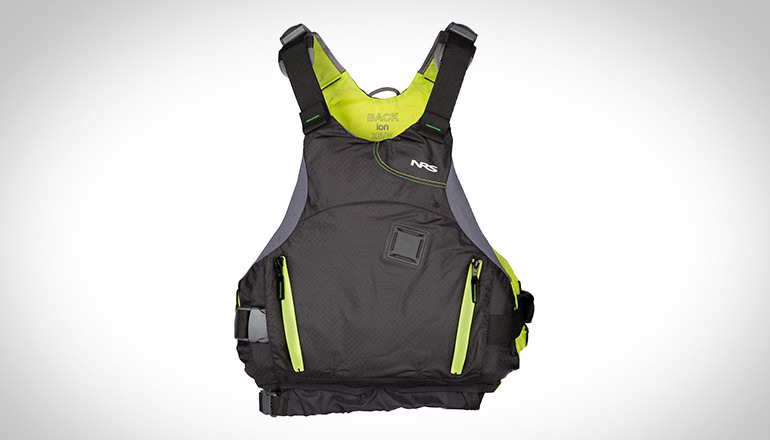
NRS Ion PFD
NRS is a famous kayak accessories manufacturer that made this Ion PFD. NRS Ion PFD is focused on flexibility to ensure that the kayaker can paddle with ease. This low-profile kayak PFD uses 200 denier ripstop nylon outer fabric with 210D nylon lining to ensure high durability to be used season after season. It got cool flow system ventilated back or AirMesh inner panels that provide ventilation throughout the jacket. The six-panel design with the ultra-soft foam ensures a soft, comfortable, and flexible fit that wraps your torso while flowing with your movements. The shoulder has been padded to increase the comfort to the wearer. As you can see in the picture, there is one dual-entry front zippered pocket that can be used to keep the essentials like a fishing plier. NRS Ion is US coast guard type III approved and has a 16.5 pounds flotation.
Notable Features:
- Available in different colors
- 210D urethane-coated ripstop nylon outer fabric
- 210D nylon lining
- Cool flow system ventilated back
- 6-panel design with ultra-soft foam
- One dual entry front zipper pocket
- Reflective accents for higher visibility
- Two shoulder and two waist adjustments
- One front lash tab
- Fleece-lined hand warmer


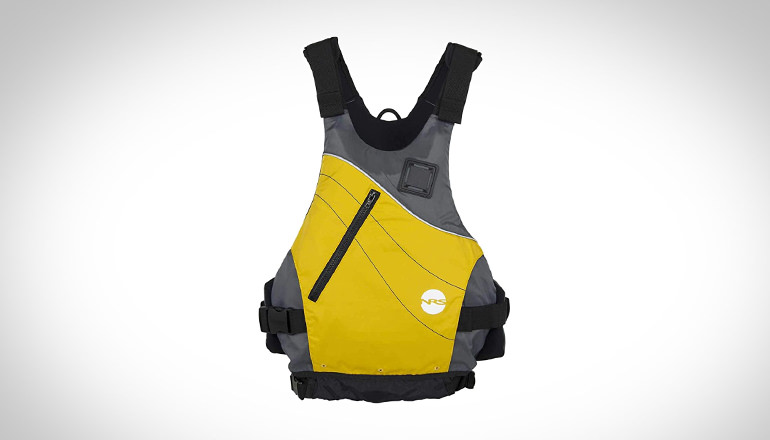
NRS Vapor PFD
NRS Vapor PFD is one of the most popular PFDs on the marFour side pulls with front waist buckle closure addion and comes with tons of cool features. 400 Denier nylon fabric is used to make the PFD fabric, which offers great durability for many many seasons. This durable ripstop nylon fabric outer shell can handle daily abuses with ease. A six-panel design constructed with soft foam offers a flexible fit that wraps your torso and ensures flexible movements. Additionally, the AirMesh inner panels provide great ventilation for hot days. The shoulder straps with strap garages have been adequately padded to make it comfortable to the users. On top of that, the six adjustment points help you achieve/lock a fit that works the best for you. It is available in different colors and sizes. Some of the colors combo come with reflective accents for higher visibility of the low-light outings.
Color: Available in 5 different colors (at the time of writing)
Size: S, M, L, XL, XXL (at the time of writing)
Notable Features:
- Easy adjustments
- Very lightweight
- Provides comfortability
- Unrestricted paddling


NRS Ninja PFD

Especially built PFD for paddlers and swimmers:
NRS Ninja is one of the best PFD for paddling, rowing, and swimming. If you are a serious paddler or swimmer who needs a PFD but doesn’t want to slow down, this NRS Ninja PFD is an excellent choice for them.
NRS Ninja PFD uses soft PVC-free foam floatation panel which is very comfortable. Ninja PFD allows four side adjustment with two shoulder adjustments for a better custom fit to different users. It’s super easy and quick to put this on or off. It offers side entry with quick release buckles.
500D Cordura shell is very sturdy to provide good protection. On the inside soft and stretchy fabric provides nice breathability. You can attach your rescue knife to the last tab. You can get this paddling PFD at different sizes, colors, and a competitive price.
Notable Features:
- Athletic design
- Side entry for easy to get in or off
- Four side adjustment with two shoulder adjustment for custom fit
- 500D Cordura shell
- Excellent PFD for paddler and swimmer
- Comfortable
- Lash tab to place rescue knife



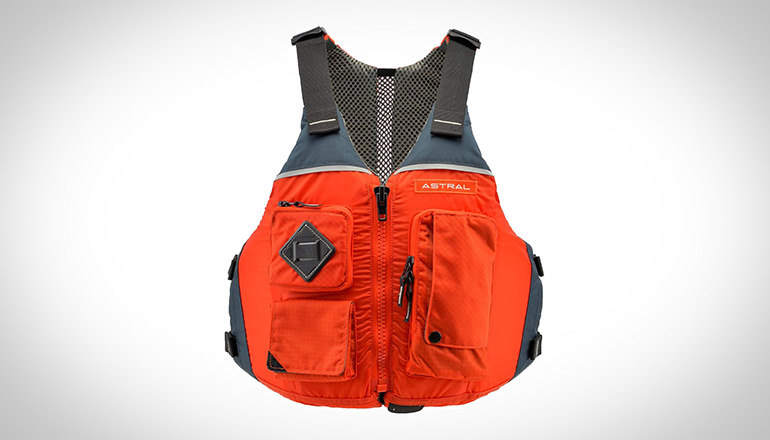
Astral Designs Astral Ronny
Best kayak PFD for fishing: This lifejacket / PFD is made for using in kayaking, canoeing, and rafting purpose. USCG certifies this lifejacket as PFD. It comes with several features and comfortable yet strong fabrics. This is perfect Lifejacket for high seat-back recreational kayaks.
Best For: Kayak fishing
Color: Saffron & Blue (at the time of writing)
Size: S, M, L, XL (at the date of writing)
Notable features:
- Excellent breathability
- Easy access pockets
- Drink holder
- Quick to access knife tab
- Mesh liner provided for extra comfort
- Made of high-quality raw materials
- 100% PE Foam

MTI Adventurewear Headwater High Buoyancy PFD Life Jacket
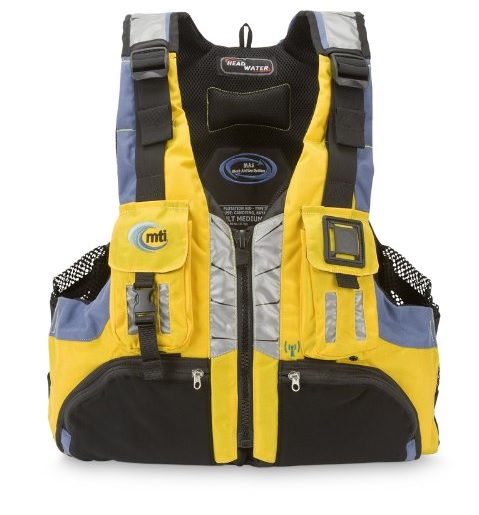
Life jacket for whitewater rafting: This PFD is made for extreme scenarios where protection is a crucial issue. This is primarily designed for the big water paddlers and professionals who are paddling on rough and tough environments. This PFD life jacket comes with a different component with four front storage pockets and two fleece-lined warmer pockets to carry important kinds of stuff. The raw materials used to prepare this has high durability and high visibility also.
Size: Xs, S, M, L, Xl, XXL (at the time of writing)
Notable Features:
- Made especially for whitewater rafting
- Several pockets for storing stuff
- High durability
- High visibility
- Excellent ventilation
- High comfortability

What is a kayak PFD?
A kayak PFD, or Personal Flotation Device, is a type of safety gear that provides buoyancy to help keep you afloat in the water. It’s a crucial piece of equipment for anyone participating in paddle sports such as kayaking, canoeing, or stand-up paddleboarding.
PFDs for kayaking are designed with mobility in mind, ensuring that you have the flexibility and comfort to paddle effectively. They typically fall under Type III and Type V categories in the U.S. Coast Guard’s classification system:
- Type III PFDs, also known as flotation aids, are suitable for conscious users in calm and inland water where there is a good chance of quick rescue. They are designed to allow the wearer to place themselves in a safe floating position, but they may not do so automatically. They are generally more comfortable and allow for more mobility than other types of PFDs, making them a popular choice for kayakers.
- Type V PFDs are special-use devices designed for specific activities, including some that are designed for paddlesports. To be used as a substitute for a Type III PFD, it must be worn and not just carried on the boat.
It’s essential to choose a kayak PFD that fits well, is comfortable to wear, and is suited to the conditions where you’ll be paddling. Kayak PFDs often have features like pockets and attachment points for gear, and they come in bright colors for high visibility on the water. As a safety device, it should be worn at all times on the water, even if you’re a strong swimmer.
USCG Rating for kayaking PFD
The United States Coast Guard (USCG) has established a rating system for personal flotation devices (PFDs) to help consumers understand the intended use, buoyancy, and limitations of different types of PFDs.
- Type I PFDs (Off-Shore Life Jackets): These PFDs offer the most buoyancy and are designed for rough, open water where rescue might be delayed. They are designed to turn most unconscious wearers face-up in the water. Type I PFDs are bulkier and less comfortable than other types, but they provide the highest level of safety. They offer a minimum of 22 pounds of buoyancy for foam models and 33 pounds for inflatable models.
- Type II PFDs (Near-Shore Vests): These are intended for calm inland water or where there is a good chance of quick rescue. They are designed to turn some unconscious wearers face-up in the water, but the turning is not as definite as a Type I. They are less bulky, more comfortable, and more affordable than Type I PFDs, but they provide less buoyancy. Type II PFDs offer a minimum of 15.5 pounds of buoyancy for foam models and 33 pounds for inflatable models.
- Type III PFDs: These are flotation aids and are suitable for conscious users in calm, inland water where there is a good chance of quick rescue. They are not designed to turn an unconscious person face up in the water, which Type II and Type I PFDs can do. However, they are generally more comfortable and allow for greater mobility than other types, making them popular for recreational water activities, including kayaking and canoeing.
- Type IV PFDs (Throwable Devices): These are not actually worn but are designed to be thrown to a conscious person in the water and grasped and held by the user until rescued. Type IV devices include buoyant cushions, ring buoys, and horseshoe buoys. They are not designed to turn an unconscious person face up in the water, nor to be worn for any length of time. They are a supplement to your wearable PFD.
- Type V PFDs: These are special use devices and are designed for specific activities such as windsurfing, waterskiing, kayaking, and rafting. Some Type V PFDs are designed to be worn and provide performance like a Type III PFD. Others, like inflatable yoke or belt PFDs, must be worn to be counted towards the vessel’s PFD requirements.
Both Type III and Type V PFDs have minimum buoyancy requirements: Type III PFDs must have at least 15.5 pounds of buoyancy, and Type V PFDs must have between 15.5 and 22 pounds of buoyancy depending on their design. It’s worth noting that PFDs should be selected based on the specific water conditions and activities they will be used for, as well as the weight and body composition of the wearer. Always ensure that the PFD is properly fitted and adjusted to the wearer to be effective. Remember, the most effective PFD is the one you will wear consistently. Even the highest-rated PFD can’t protect you if you’re not wearing it.
How to Choose the Best PFD For Kayaking?
- Comfort: When you’re out on the water, you’ll wear your PFD for extended periods, so it must be comfortable. Paddling a kayak requires a range of motion in your arms and torso, so any PFD you wear mustn’t impede that movement. Some PFDs are specifically designed for paddling sports, with features like larger armholes and foam panels positioned to enhance movement. Comfort also depends on the climate and the conditions where you’re kayaking. A PFD with good ventilation can help you avoid overheating if you’re in a warm environment. On the other hand, if you’re in a colder climate, a PFD with more coverage can help to keep you warm. The PFD should have adjustable straps around the waist, shoulders, and possibly the sides to make sure it can be tailored to your body shape. When trying on the PFD, you should mimic your movements while kayaking to see if it rubs or causes any discomfort.
- Entry Style: Sure, the entry style of a PFD is an important factor to consider when choosing one for kayaking. There are typically three types of entry styles:
1. Over-the-head: This is the most common entry style for kayaking PFDs. It involves a single large hole for your head, and the PFD rests on your shoulders like a vest. The sides are typically open to help with ventilation and allow for greater movement, and they fasten with buckles or a zipper. Over-the-head PFDs are often highly adjustable and come with numerous features like pockets and attachment points. They’re usually the preferred choice for recreational and sea kayakers due to their balance of comfort, safety, and utility.
2. Front-zip: Front-zip PFDs zip up in the front, much like a jacket. They tend to offer a secure and snug fit, with many having adjustable straps for a more personalized fit. These PFDs may have pockets or other utility features, although perhaps not as many as the over-the-head style. One downside is that the zipper, if not well-maintained, could fail over time.
3. Side-zip: Side-zip PFDs are popular among some kayakers, especially in the whitewater community. They zip up along the side and often offer a large, unobstructed front panel, which can be useful for active paddling. They can be a bit trickier to put on and take off, especially if you have limited shoulder mobility. - Fit: A PFD’s fit is crucial for comfort and safety. A too-loose PFD can ride up and interfere with your breathing if you end up in the water. Conversely, a too-tight PFD might restrict your breathing and movement, even when you’re out of the water. When checking the fit, fasten all the straps and then test it by pulling up on the shoulders of the PFD; it should stay in place and not slide up. If it does, it’s too big. You should also be able to breathe easily and have full mobility in your arms.
- Type: Personal Flotation Devices are classified into five types (I-V) by the US Coast Guard based on their buoyancy, intended use, and the water conditions they are designed for. Type III PFDs, often called flotation aids, are designed for calm water where a quick rescue is likely. They are generally lightweight and designed for comfort, allowing for a good range of motion, making them a popular choice for recreational kayaking. Type V PFDs are special-use devices designed for specific activities. Some Type V PFDs are designed specifically for kayaking and have features like pockets for gear storage and lash tabs for attaching tools and equipment. However, they must be used for the activity they are designed for to meet safety standards. Regardless of your chosen type, it should be a model specifically designed for kayaking or paddling sports. These PFDs will have the necessary design features to provide safety and comfort during your kayaking adventures.
- Buoyancy: Buoyancy refers to the PFD’s ability to keep you afloat in the water. The buoyancy of a PFD is determined by the amount of flotation material it contains, and it’s measured in pounds. The more flotation material, the higher the buoyancy, and the more it can support in the water. Adult PFDs usually provide between 15.5 to 22 pounds of buoyancy, but the amount of buoyancy you need can depend on several factors. For example, if you’re kayaking in rough water, you may want a PFD with higher buoyancy to help keep you afloat amidst the waves. Similarly, if you’re a poor swimmer, extra buoyancy can provide additional safety. Clothing and gear can also affect buoyancy. If you’re kayaking in cold water and wearing heavy clothing, you may require a PFD with more buoyancy to counterbalance the extra weight and keep you afloat.
- Features: While the primary purpose of a PFD is to keep you afloat, many come with additional features that can enhance your kayaking experience. For instance, pockets can provide handy storage for small items like snacks, sunscreen, a compass, or a small first-aid kit. Other useful features might include attachment points or lash tabs. These can be used to secure essential tools such as a knife, whistle, or strobe light. Some PFDs even have integrated hydration bladders or fishing gear attachment points.Keep in mind, though, that while these features can be useful, they should not compromise the fit, comfort, or buoyancy of the PFD.
- Color: The color of your PFD isn’t just a matter of personal style; it can also play a significant role in your visibility on the water. Bright colors such as orange, yellow, or red are more easily spotted from a distance than darker colors. This can be essential if you find yourself in need of rescue, as it allows others to spot you more quickly.Apart from visibility in rescue scenarios, bright colors can also help avoid collisions by making you more visible to other water users, such as power boaters. Even if you are a strong swimmer and not concerned about falling in, it’s worth considering a brightly colored PFD for this reason alone.Reflective strips are also a great feature for increasing visibility, particularly in low light conditions or if you plan to kayak at dawn, dusk, or night.
- Testing: If you have the opportunity, it’s a great idea to test your PFD in a controlled environment, such as a swimming pool or a calm, shallow body of water. This test will allow you to see how the PFD performs under actual water conditions. When testing, put on the PFD and fasten all closures and adjustments as you would when using it for kayaking. Then, get into the water and note if the PFD stays in place or rides up towards your head, which could restrict your movement and breathing. The PFD should keep you floating with your head above the water, and ideally, it should naturally position you on your back, which is the safest position if you are unconscious or unable to swim. If you find it difficult to maintain this position or if the PFD rides up, it might not fit correctly, or it might not have enough buoyancy for your weight and the weight of your gear. This test can also be an opportunity to practice getting back into your kayak while wearing the PFD, which can be more challenging than without it.
- Certification:A certification from a recognized authority is an assurance that the PFD has been tested and proven to meet certain safety standards. It’s crucial to ensure the PFD you choose is certified by the appropriate authority in your country. For example, in the United States, PFDs should be certified by the U.S. Coast Guard (USCG). This certification indicates that the PFD has passed the USCG’s rigorous testing for things like buoyancy, strength, and durability. In Europe, look for PFDs that meet or exceed the ISO 12402 standard, which is the European standard for life jackets. It’s worth noting that a PFD that isn’t certified isn’t necessarily unsafe, but a certification gives you an added level of assurance about the PFD’s performance and safety. Always check for a certification label or stamp on the PFD.
FAQ – Kayak PFD
Typically, a Type III or Type V PFD is recommended for kayaking. These types offer a good balance between buoyancy and freedom of movement. Some Type V PFDs are even specially designed for paddlesports.
Yes, it’s highly recommended to always wear a PFD while kayaking. Regardless of your swimming ability or the conditions, a PFD is a crucial piece of safety equipment that can save your life in an emergency.
A kayak PFD should fit snugly without being too tight. You should be able to move your arms freely and it shouldn’t ride up when you’re in the water. Adjustable straps can help you achieve the right fit.
Bright colors like orange, yellow, or red are often recommended because they make you more visible in the water, which can be important in a rescue scenario
Adult PFDs typically provide between 15.5 to 22 pounds of buoyancy. You might need a PFD with more buoyancy if you’ll be kayaking in rough water, if you’re a poor swimmer, or if you’ll be wearing heavy clothing.
Yes, your PFD should be certified by the relevant authority in your country, such as the U.S. Coast Guard in the United States. This certification ensures that the PFD meets certain safety standards.
Rinse your PFD with fresh water after each use, especially if you’ve been in salt water or dirty water. Let it air dry out of direct sunlight. Inspect it regularly for damage, and replace it if the buoyancy material is degrading or if the straps or closures are worn or damaged.
You should check your PFD regularly for any signs of wear and tear, such as tears in the fabric, fraying straps, or damaged buckles or zippers. Also, test its buoyancy by jumping into shallow water with it on to see if it still keeps you afloat effectively. If it’s heavily faded, it could mean the material has been weakened by sun exposure.
Inflatable PFDs can be suitable for some types of boating but are generally not recommended for activities like kayaking, where there’s a high likelihood of capsizing. They require you to manually inflate them or they inflate upon immersion in water, which may not be reliable in an unexpected situation.
USCG stands for United States Coast Guard. A USCG-approved PFD has been tested and certified by the Coast Guard to meet safety standards for buoyancy and durability.
PFDs should be rinsed with fresh water after each use, particularly if you’ve been kayaking in salt water or dirty water. If needed, you can clean it gently with mild soap. Always allow it to air-dry out of direct sunlight, as the sun can degrade the material over time.
It’s not recommended to store your PFD in your kayak if it’s exposed to the elements, as sun and rain can degrade the PFD over time. It’s best to store your PFD in a dry, cool, and well-ventilated place out of direct sunlight.
No, children should always wear PFDs that are specifically designed for their size and weight. An adult PFD will not fit a child correctly, which could impair its effectiveness.
A Type V PFD is a special-use personal flotation device that is designed for specific activities. Some Type V PFDs are designed for paddling sports and may have features like large armholes for paddling freedom, pockets for storage, and tabs for attaching equipment.

Afsar is an avid kayak blogger born near the coast. He has a passion for kayaking and started as a child. He has paddled in various conditions and locations and promotes responsible kayaking. Afsar’s blog is widely read, and they are a respected voice in the kayaking community, offering valuable content on kayaking trips, gear, tips, and tricks. Afsar collaborates with other bloggers and brands and continues to inspire others through their writing and social media.

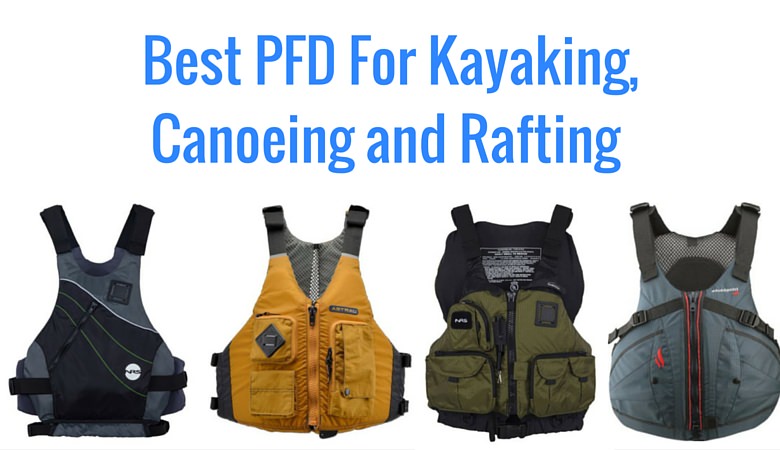
Using adventurer pfd, best for rafting. Highly recommend.
Thanks for sharing your valuable opinion with us. See ya around.
Oh I have a pfd, but they came out of my big boat and suck for kayaking. Just have to make due for now. That’s why I’m only fishing the Brazos mostly. It’s shallow and slow so I don’t have to wear it all the time. Another reason I can’t fish the tournaments. I do wear it and just deal with it when at the lake.